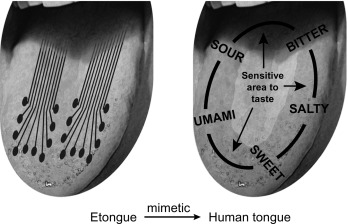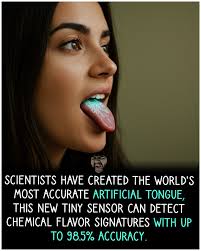Table of Contents
Introduction to the concept of electronic tongue
What would our world be like when machines can taste food too? Sounds sci-fi, no? Introduce the world of electronic tongues, a technological wonder that is made to replicate human sensations of taste. These advanced gadgets have made an impact in several domains, however, they still do not manage to grasp the depth and detail that our five senses can enjoy. With the ever-growing consumer crush on quality and consistency there is a pressing need to innovate in the field of flavor analysis.
Why not improve on these electronic tongues using cutting edge materials? Allow us to introduce you to graphene, a magnificent material that has rocked the scientific fraternity. A graphene-based electronic tongue will not only be capable of simulating human taste, but perhaps transforming it all together thanks to its many special characteristics. The adventure into this promising frontier can provide an unlimited environment both to technology and gastronomy!
The limitations of traditional tasters and the need for innovation

The traditional tasters, which are usually considered the archetype of flavor measurement, have their shortcomings. The human taste is not objective and is also affected by many factors such as mood, health, even the culture of a person. Such a subjection may create variability of tastes.
In addition, the human palates may fatigue with repeated tastes. Exhaustion distorts perception and it becomes difficult to tell differences in flavors accurately. Not all people would feel the same when it comes to the sensitivity of their system- what a person may find to be lovable, another would feel that it is too much.
As the pressure to achieve consistency in food quality and flavor profilers increases, the traditional ways cannot be used on their own anymore. The innovation is urgent, since we need tools that would give us sound data free of personal bias and fatigue problems.
The emerging technologies will offer promises which would transform our way of judging taste. The demand for accuracy has never been more important in a business where only fine details mean the difference between customer satisfaction and brand loyalty.
What is Graphene and how does it work as an electronic tongue?
Graphene is a single layer of atoms with carbon in a two dimensional honeycomb like lattice structure. This spectacular material has grabbed the limelight due to its spectacular electrical, thermal and mechanical characteristics.
When applied as an electronic tongue, graphene reacts with different chemical elements of food and drinks. Its large surface area enables it to pick even slight variations of the taste profiles.
It is based on sensors with the help of which the conductivity of the graphene is used. At the point when the molecules of various substances are attached to the surface of the graphene, they change its electrical resistance. A precise degree of these alterations may be recorded.
The sensitivity resembles the human taste sensation in differentiation of tastes, such as sweet, bitter, sour acid, salty, and the savoury umami taste. With every study the possibility of developing more sophisticated tasting methods increases exponentially.
Advantages of using Graphene-based electronic tongue
Numerous benefits of using graphene-based electronic tongues can be associated with the differences of the technique when compared to the traditional approaches of tasting. One of the greatest assets is their accuracy. These devices are consistent and objective since the result is not based on the taste of a person.
Another great feature is speed. Graphene electronic tongue can do sample analysis in real-time and this cuts down significantly on the time consumed in quality control of food production.
Moreover, the sensitivity of their appetite in different compounds enables them to capture even such delicate flavoring which would be beyond the detection of even the taste-experienced. This accuracy will help companies tailor up their products to the needs of consumers much better.
In addition, graphene has special characteristics which render these e-tongues resistant and versatile in diverse conditions. They can adapt to various conditions and still give a certain precise performance.
The implementation of such technology in the line of production shall provide cost saving options as a little is wasted as well as the best flavour being produced before it is on the plate of the consumer.
Potential applications in food and beverage industry
With electrical tongues implemented on graphene, the food/beverage sector approaches a turning point of a significant change. The new gadgets are capable of analyzing taste-profiling very accurately, providing information that the conventional tasters can miss.
And think of a wine factory where quality control can be improved with the help of an electronic tongue that is sensitive to very small flavourings. Manufacturers would be able to maintain uniformity in batches, making products that are perfected.
In restaurants, it may be possible that the chef is using the technology to make personalized dishes perfectly underlining the taste that suits the customer. A digital tongue would be able to process ingredients and the best mix to achieve good taste.
There is also the important area of food safety. Quality standards are enhanced and consumers are trusted by the characteristic of quality judgement of spoilage or contamination at a short notice.
In such developments, the future of ways to improve tastes and guarantee quality is endless in a fast emerging food industry.
Future possibilities and research advancements
The prospect of electronic tongues using graphane is tremendous. Researchers are working on materials and methods of making them more sensitive and accurate.
The promising field of development is combining it with artificial intelligence. When AI algorithms are combined with such devices, it is possible that the taste profiles will be even more specific and imitate human perception in detail.
In addition, there is an upcoming miniaturization. Consider mobile or wearable units able to process chemistry of the food right before the eyes, giving real time feedback on taste notes or allergens.
The next-generation sensors can also be produced with different applications in mind, that is, not only food tasting as one might think of pharmaceutical applications or environmental monitoring. Graphene has versatility that enables it to fit in any industry.
With research still in its developing stages, it is probable that multidisciplinary research will advance the breakthrough in new improved results, within the confines of the laboratory and the real world.
Conclusion
By establishing the graphene-based electronic tongue, this marks a significant change by which we view the process of taste and flavor evaluation. This new technology confines the general constraints of the traditional options of taster as this is precise and reproducible; something that is commonly lacking when it comes to human sensory analysis. Graphene has unusual characteristics, which offer an unsurpassed ground in studying the mechanisms involved in human perception of taste.
The possibilities are numerous as the industries keep on discovering the use of this revolutionary tool. Whether in controlling quality in the food industry or customization of flavor in drinks, the electronic tongue made of graphene may be the defining quality in various industries. In addition, a research being conducted further points to even greater advanced modifications in the future.
There is potential to incorporate these technologies in daily usage. With time, as scientists and engineers perfect their strategies, we are most likely to experience the revolution not only in test methods but also in product development. A combination of technology with food art may stagger into a new unprecedented age of innovations proving to be fun loving and assuring safety besides warranting quality each and every step along the front.
When you watch exciting things develop in this field, one can realize readily that we will be accepting such innovations as the graphene-based electronic tongue- one that will make us understand (and feel) taste itself.
